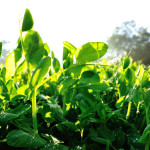 Conservation farming entails the use of practical steps that can anticipate climate change effects such as drought to avert food insecurity. Farmers in the dry areas of Kenya are practicing the method through the use of zero grazing in herds to reduce pressure on grass and planting drought resistant crops. Conservation is also taking place through the use of crop-friendly sprays that enable plants to survive frost and pests without exceeding the minimum residual levels of chemicals. This last step is helpful in the prevention of losses for farmers who fear their crops will be unacceptable if they spray them with common chemicals.
Conservation farming entails the use of practical steps that can anticipate climate change effects such as drought to avert food insecurity. Farmers in the dry areas of Kenya are practicing the method through the use of zero grazing in herds to reduce pressure on grass and planting drought resistant crops. Conservation is also taking place through the use of crop-friendly sprays that enable plants to survive frost and pests without exceeding the minimum residual levels of chemicals. This last step is helpful in the prevention of losses for farmers who fear their crops will be unacceptable if they spray them with common chemicals.
In all, there are three elements of conservation agriculture according to the Food and Agriculture Organization (FAO). These include:
1. Low tillage to reduce soil disturbance.
2. Having a long-lasting, natural soil cover.
3. Practicing crop rotation.
Low tillage for reduction of soil disturbance is founded on the belief that the topsoil contains the most nutrients. Thus, avoiding unnecessary digging helps retain these nutrients concentrated in place where crops can assimilate them. Trends of this practice in Kenya include:
•Use of donkey or ox pulleys. This is a practice of harrowing land without digging the entire area. The pulleys only dig the exact place where seeds will be planted.
•Use of recommended herbicides to selectively kill weeds that usually take over in untilled land. Currently, farmers use glyphosate and other chemicals but better eco-friendly varieties are available.
•The use of mechanical low-tilling implements such as seeder tractors and ripper machines selectively till the land without digging too deep.
The second aspect of having permanent natural soil cover is important because exposed soil is open to erosion which drains off minerals, which leaves farms sandy and infertile. This is possible through the retention of grass patches in plots of land. These provide necessary camouflage for soil enriching worms and facilitate nutrient retention. Other ways Kenya farmers are achieving these aims include:
•The use of mulch. The main sources of mulch comes from the remains of leguminous harvests such as bean leaves and pods. Banana leaves also provide strong soil cover.
•Reduction in overgrazing is another way of retaining grass patches in farms. Overgrazing undermines the top soil and uproots nitrogen-fixing members of the grass family.
•The growth of desmodium, a type of vegetation which doubles as ‘live mulch:’ it increases nitrogen in the soil and provides fodder for cattle when it is cut.
The third aspect of conservation agriculture in Kenya is a traditional recourse and one in which many cash and subsistence crops co-exist. For instance, to drive amy worms away, farmers intercrop legumes with maize on the fringes of napier grass. The following are some new crops driving intercropping:
•Exports of French beans in Kenya have increased in recent years because of the embracing of French bean and maize intercropping. This is happening in Trans-Nzoia and Nandi Hills in the West Rift of the country.
•In all parts of cash crop-growing regions, different crop combinations are also proving lucrative. Some prominent examples of export crops include:
1.Onions with tomatoes: because both crops require similar husbandry in drip irrigation, it is easy to grow them in the same plot of land.
2.Tomatoes and cabbages: in both large-scale and small-scale farms, brassica family crops like kales, cabbages and spinach do well in the same plot with tomatoes, all key exports.
3.Pigeon pea and corn: While maize is the staple of the country, it stagnates from lack of nitrogen which cash crops like pigeon peas fix in the soil even as they serve as food.
4.Maize and desmodium/brachiaria: in the popular row-based cultivation method known as push-pull, desmodium and brachiaria grass grow around maize crops. The vegetation not only adds mulch to the soil but assists in the feeding of domestic animals.
5.Other lists for East African intercropped annuals plants include: cotton versus beans, cassava versus bananas, cashew nuts versus mangos, maize/sorghum versus sesame, brassica family versus legumes like green grams and cowpeas.
Therefore, the more crop conservation takes place in Kenya, the more it will be possible to enjoy the fruits of the fields. From row or mixed intercrops to traditional tilling or modern tilling that does not unearth much of the soil, it will be possible to mitigate the elements of climate change. There are also the programs in semi-arid highlands like Makueni where farmers use mulch to improve soil and reduce the famine, normally occasioned by soil erosion. It is these parameters that have also boosted export crops for farmers.

